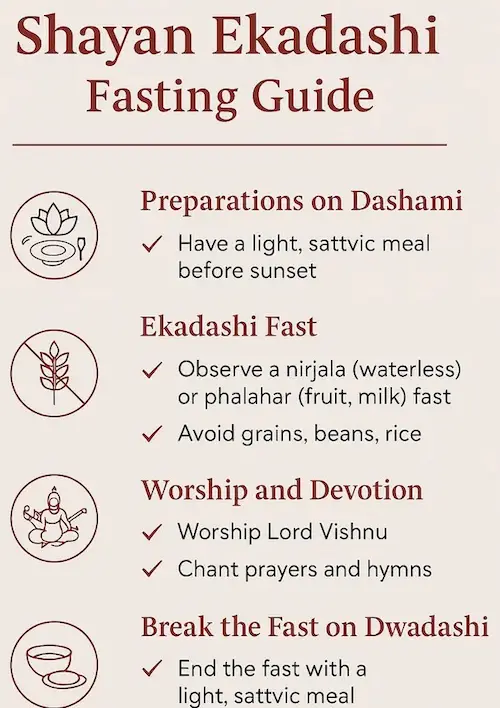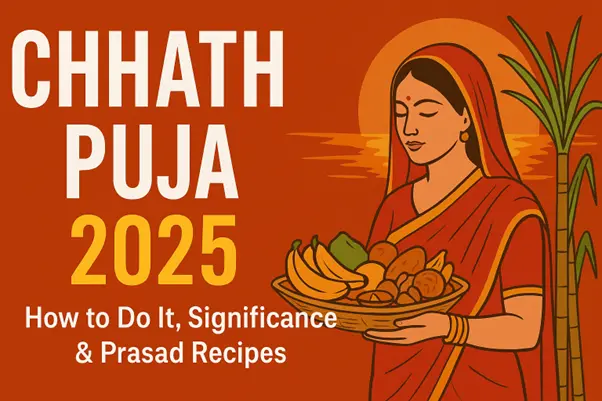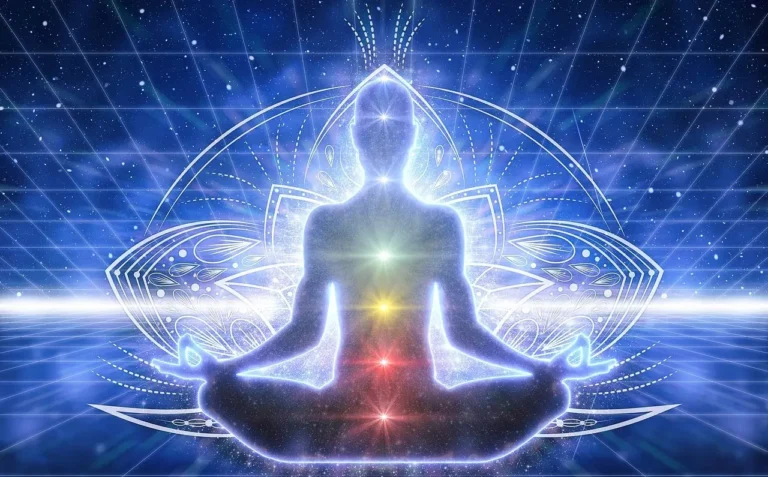
Embracing Divine Rest and Spiritual Awakening
The Cosmic Pause: Shayan Ekadashi and the Celestial Slumber
In the rich fabric of Hindu cosmology, time is cyclical, sacred, and infused with divine meaning. Shayan Ekadashi, also known as Devshayani Ekadashi, falls on the eleventh day (Ekadashi) of the waxing moon phase in the month of Ashadha. It marks the beginning of Lord Vishnu’s four-month cosmic sleep, a period of divine withdrawal known as Yoga Nidra.
Symbolically, this is a celestial pause. Vishnu, the preserver of the universe, reclines upon the serpent Ananta Shesha amidst the milky ocean (Kshira Sagara), relinquishing his waking duties and ushering in a phase for humans to turn inward. Devotees observe fasts, offer prayers, chant mantras like “Om Namo Bhagavate Vasudevaya”, and participate in temple rituals that echo both reverence and stillness.
This divine sleep is not just metaphorical, it is a reminder that rest is sacred, and so is silence. In Maharashtra, lakhs of pilgrims make a profound journey to Pandharpur for Ashadhi Ekadashi, where devotion takes the form of music, walking pilgrimages (Wari), and collective worship of Lord Vitthal, a form of Vishnu.
Shayan Ekadashi (Devshayani Ekadashi)
Observed on the 11th lunar day (Ekadashi) of the bright fortnight of Ashadha (June-July), Shayan Ekadashi is revered by Vaishnavas as the day Lord Vishnu enters his cosmic slumber, Yoga Nidra, on the celestial serpent Sheshanaga, floating in the ocean of milk (Kshira Sagara).
Key Significance:
- Marks the start of Vishnu’s four-month rest, ending on Prabodhini Ekadashi in Kartik (October-November).
- Devotees observe fasts, chant Vishnu’s names, and take vows of spiritual discipline.
- In Maharashtra, it culminates in the grand Pandharpur Yatra, where lakhs of devotees walk to the Vitthala temple in Pandharpur.
Spiritually, it symbolizes introspection and surrender, as the deity rests and the devotee turns inward.
The fasting rituals of Shayan Ekadashi, also known as Devshayani Ekadashi are deeply symbolic and spiritually enriching.
How to observe the fast:
1. Preparations Begin on Dashami (the 10th lunar day/5th July 2025)
- Light, sattvic dinner is taken before sunset.
- Devotees avoid grains, beans, onions, garlic, and tamasic foods.
- Many observe brahmacharya (celibacy) and refrain from indulgences.
2. Ekadashi Day: The Sacred Fast on 6th July 2025
- Complete fast (nirjala) is observed by some—no food or water.
- Others follow a phalahar fast, consuming only fruits, milk, and water.
- No grains, pulses, or rice are consumed, as they are believed to absorb negative energies on this day.
- Devotees wake early, bathe, and wear clean clothes before beginning prayers.
3. Worship and Devotion
- Offerings are made to Lord Vishnu, especially in his reclining form (Shayan Mudra).
- Chanting of Vishnu Sahasranama, Bhagavad Gita, or the mantra “Om Namo Bhagavate Vasudevaya” is encouraged.
- Temples often hold special aartis and bhajans throughout the day.
- Many observe night-long vigil (jagaran), singing devotional songs and meditating.
4. Breaking the Fast on Dwadashi (the 12th lunar day / 7th July 2025)
- The fast is broken after sunrise with light, sattvic food, often after offering food to a Brahmin or the needy.
- It’s considered auspicious to donate clothes, food, or money on this day.
These rituals are not just about abstaining from food, they’re about cleansing the body, calming the mind, and awakening the soul. The fast aligns the devotee with the divine rhythm of the cosmos, as Lord Vishnu enters his celestial rest.

Chaaturmaas: Four Months of Inner Alchemy
As Vishnu retires into slumber, humans enter Chaaturmaas, literally “four months.” These months Shravan, Bhadrapada, Ashwin, and Kartik correspond with the monsoon, a season of abundance, rhythm, and renewal.
But Chaaturmaas is not a season of indulgence. Instead, it is a call for austerity and heightened awareness. Traditionally, saints, sages, and householders alike observe vows, vratas ranging from dietary restrictions (avoiding onions, garlic, fermented foods) to refraining from travel, celebrations, and consumption of intoxicants. This pause from worldly pleasures is aimed at rejuvenating the body and purifying the mind.
Why It Matters:
- It’s a time of austerity, devotion, and self-restraint. Many take vows like avoiding certain foods, practicing silence, or increasing spiritual study.
- Mythologically, it’s when Vishnu resides in the netherworld (Sutal Lok) with King Bali, fulfilling a boon granted during his Vamana avatar.
Auspicious ceremonies like weddings are avoided, as the period is meant for spiritual renewal, not worldly celebrations.
Each month of Chaaturmaas is associated with a distinct spiritual energy:
- Shravan is dedicated to Lord Shiva, amplifying the energy of devotion and surrender.
- Bhadrapada welcomes Lord Ganesha, signaling wisdom and obstacle removal.
- Ashwin celebrates Goddess Durga and the triumph of light over darkness.
- Kartik culminates with Vishnu’s awakening and the festival of lights, Diwali.
The philosophy is beautiful: when the gods rest, humans rise in tapasya (austerity), preparing themselves for deeper spiritual growth. It reflects an ancient environmental wisdom too, restraint during the rainy season ensured health and ecological harmony.
The Spiritual Invitation: Rest, Reflect, Realign
Beyond ritualistic fasting or refraining from worldly joys, Shayan Ekadashi and Chaaturmaas beckon something deeper, a spiritual recalibration. It is an opportunity to slow down the cycles of busy-ness and reclaim inner sanctity.
In modern times, when life moves at unrelenting speeds and silence is often drowned in digital noise, these observances offer a counterbalance. Just as Vishnu sleeps in the celestial waters, we too are asked to dive inward, into introspection, surrender, simplicity, and sattvic living (purity in thought, action, and consumption).
For content creators, artists, and seekers, Chaaturmaas becomes a fertile ground. It nurtures creativity by stripping distractions away. For families, it’s a season to bond over bhajans, temple visits, or simply a shared vegetarian meal. For the elderly, it’s time to pass down traditions. And for the youth, it’s an initiation into the timeless rhythm of sacred living.
Conclusion: The Pause That Elevates
When Lord Vishnu closes his eyes, it is not an absence. It’s a presence of a different kind, the kind that whispers, “Go within.” And when the rains pour over the subcontinent, they echo a cleansing, not just of lands, but of spirits. By observing Shayan Ekadashi and immersing ourselves in the practices of Chaaturmaas, we align with nature, elevate our consciousness, and prepare the soil of the soul for divine seeds to sprout. In a world that idolizes hustle, this tradition teaches us the sacredness of rest and the transformative power of stillness.
FAQ: Frequently Asked Questions
What is Shayan Ekadashi and why is it significant?
Shayan Ekadashi, also known as Devshayani Ekadashi, marks the beginning of Lord Vishnu’s four-month cosmic slumber. It signifies a time for spiritual pause, introspection, and the start of Chaaturmaas.
When is Shayan Ekadashi observed in 2025?
In 2025, Shayan Ekadashi falls on Sunday, 6th July, with preparations beginning on Dashami, Saturday, 5th July.
What is Chaaturmaas and how long does it last?
Chaaturmaas means “four months” and spans from Shayan Ekadashi to Prabodhini Ekadashi. It includes the lunar months of Shravan, Bhadrapada, Ashwin, and Kartik.
What are the fasting rules for Shayan Ekadashi?
Devotees observe a fast by avoiding grains, pulses, and tamasic foods. Some follow a nirjala (waterless) fast, while others consume fruits, milk, or sattvic meals.
Can Chaaturmaas be observed at home?
Yes. Many householders take personal vows, like avoiding certain foods, increasing prayer, or reading scriptures, to align with the spirit of Chaaturmaas.
Why are weddings and celebrations avoided during Chaaturmaas?
This period is considered spiritually intense and introspective. It’s meant for penance, not worldly festivities, hence weddings and major celebrations are postponed.
What is the connection between Lord Vishnu and Chaaturmaas?
According to legend, Vishnu rests in the netherworld (Sutal Lok) with King Bali during Chaaturmaas, fulfilling a boon granted during his Vamana avatar.
What rituals are performed on Shayan Ekadashi?
Devotees worship Vishnu in his reclining form, chant mantras, perform aartis, and often stay awake through the night in devotional vigil (jagaran).
Is it necessary to fast for all four months of Chaaturmaas?
Not necessarily. Devotees may choose specific Ekadashis or take up manageable vows. The focus is on sincerity and spiritual discipline, not rigidity.
How can one spiritually benefit from observing Chaaturmaas?
By embracing simplicity, devotion, and self-restraint, one cultivates inner peace, clarity, and a deeper connection with the divine rhythm of life.
Stay updated with the latest news on Rapido Updates. Keep yourself updated with The World, India News, Entertainment, Market, Gadgets, Sports, and many more..
Also read – Snoring and Heart Health: The Hidden Risks & Secrets to Sound Sleep




1 thought on “Shayan Ekadashi & Chaaturmaas: Embracing Divine Rest and Spiritual Awakening”